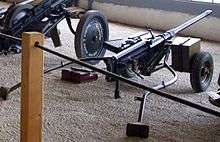Solothurn S-18/1000
| Solothurn 20 mm Tb S-18/1000 | |
|---|---|
|
please note that the photograph shows the earlier S18-100 rather than the S18-1000 | |
| Type | Anti-tank rifle, Anti-materiel rifle |
| Place of origin |
Nazi Germany Switzerland |
| Service history | |
| Used by |
Nazi Germany Kingdom of Italy China Netherlands Indies Kingdom of Hungary Finland (trials only) |
| Wars | World War II |
| Production history | |
| Variants | Solothurn S-18/100, Solothurn S-18/1100 |
| Specifications | |
| Weight | 118 lbs (53.5 kg)(empty) |
| Length | 85 inches |
| Barrel length | 57 inches |
|
| |
| Cartridge | 20×138mmB (Solothurn Long) |
| Caliber | 20 mm |
| Action | semi-automatic |
| Muzzle velocity | 850 m/s |
| Feed system | 10 rounds |
The Solothurn S18-1000 20 mm Anti-Tank rifle was a Swiss and German anti-tank rifle used during the Second World War. It was a variant of the earlier S-18/100 with modifications for a higher muzzle velocity, as well as a larger cartridge size. The more powerful ammunition resulted in significant recoil, which was problematic for the gunner, and its size made portability difficult.


History
The Solothurn firearms company was owned by the German firm Rheinmetall, who used the Swiss company to manufacture arms which were prohibited for manufacture by any German firm under arms limitations imposed at the end of the First World War.
In 1940–1941 the US Army considered adopting the Solothurn S18-1000. The weapon was standardized for limited procurement as 20mm automatic gun T3. In spring 1941 the Solothurn was tested against the Colt .90-cal. (23mm) T4 automatic gun, an aircraft gun. Although not as powerful, the Solothurn was less bulky and complicated and was found more suitable for Army use. The plans were to acquire an order of 50 pieces and later to produce the weapon in the US. However, long contract negotiations resulted in abandonment of the planned purchase.[1]
It was adopted by the Royal Italian Army in 1940, when a first batch was bought from Switzerland; initially known as Carabina "S" (S carbine), from 1942 it was designated as Fucile anticarro "S" (S anti-tank rifle); employed primarily on vehicles given its size and weight, it was largely employed in North Africa; after the 8 September 1943 it was also used by the National Republican Army of the Italian Social Republic.[2]
Specifications
- Service History: Used by Germany, Italy, Hungary, the Netherlands, and Finland during World War II and Finland's Continuation War.
- Overall length: S18-1000 and −1100 85-inch. This could vary due to a number of optional muzzle brakes used for different projectile weights.
- Barrel length: 51-inch muzzle brakes length: 1-hole brake, 1 inch; 4-hole, 4 inches; 5-hole, 5 inches. The brake adds to the overall length of the barrel when installed.
The brakes are changed depending on the recoil force of the rounds being fired. Lighter projectiles require less recoil reduction from the brake to allow the action to cycle. Therefore, the one-hole brake is used for firing high-explosive projectiles, which are much lighter than the armour-piercing variety. The AP projectiles require the 5-hole brake.
- Weight: S18-1000 and −1100 118 lb empty with magazine (4 lb)
- Cartridge: S18-100 20mmX105B, S18-1000 and −1100 20×138mmB. The B indicates a "belted" round which headspaces on the belt rather than the shoulder, rim or mouth of the case
- Caliber: .818" or 20.5mm (bore diameter is larger than the land diameter of 20mm or .78")
- Action: Recoil-operated semi-automatic for the S18-100 and S18-1000. The S18-1100 was select-fire recoil-operated.
- Magazine capacity: S18-100 5- or 10-round, S18-1000 and −1100 10-round standard, but the weapon could use the 20-round magazines from the Flak 30 anti-aircraft gun.
See also
- L3/35, for the "L3 cc" anti-tank (controcarro) tank destroyer
Notes
References and external links
- Zaloga, Steven J., Brian Delf – US Anti-tank Artillery 1941–45 (2005) Osprey Publishing, ISBN 1-84176-690-9.
- Photos of the Solothurn S-18/1000
- ramon Bill, Waffenfabrik Solothurn, Schweizerische Präzision im Dienste der deutschen Rüstungsindustrie, 2002 by Altes Zeughaus Museum Solothurn.
